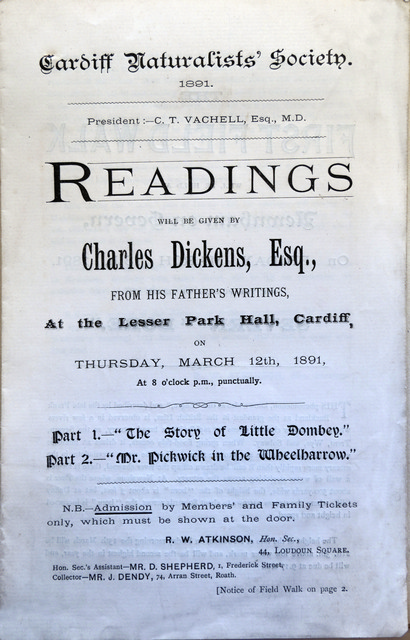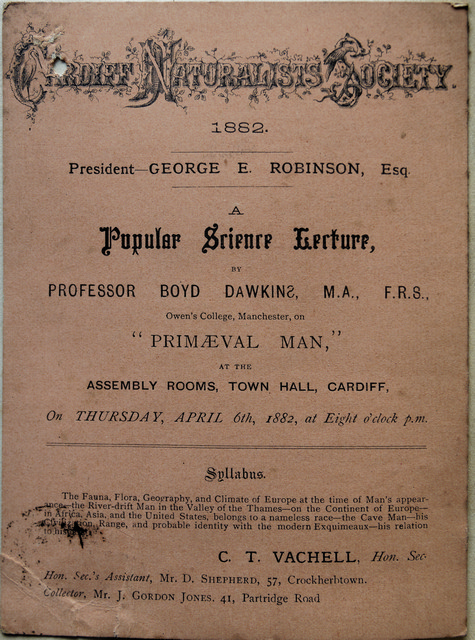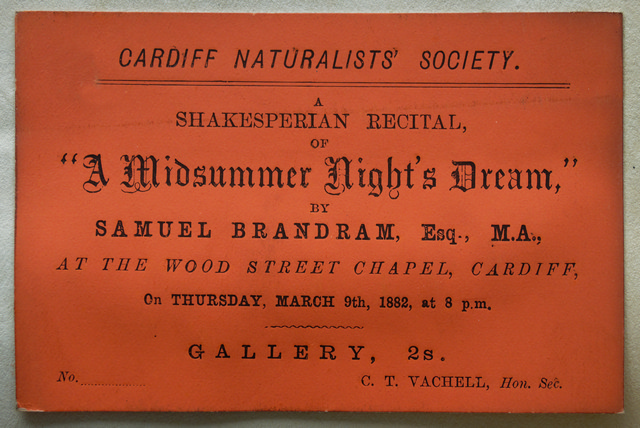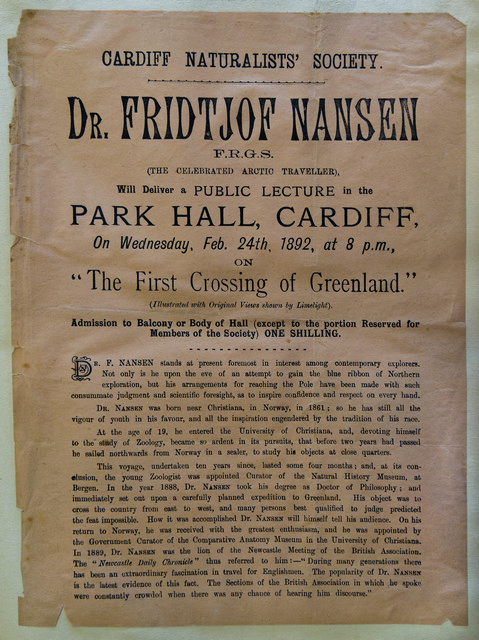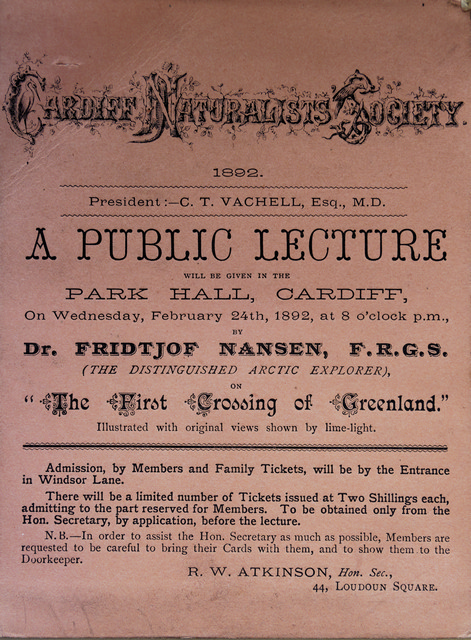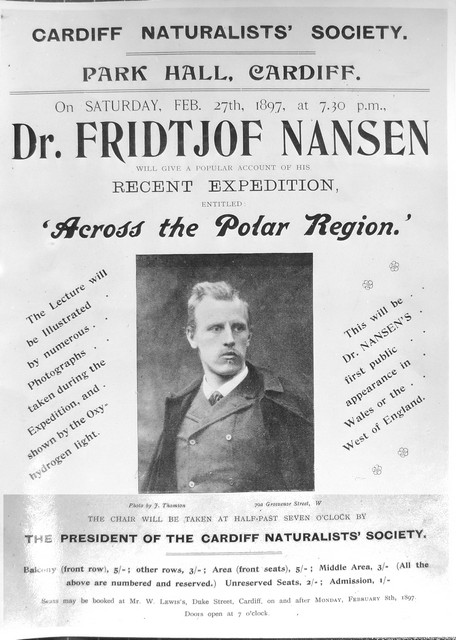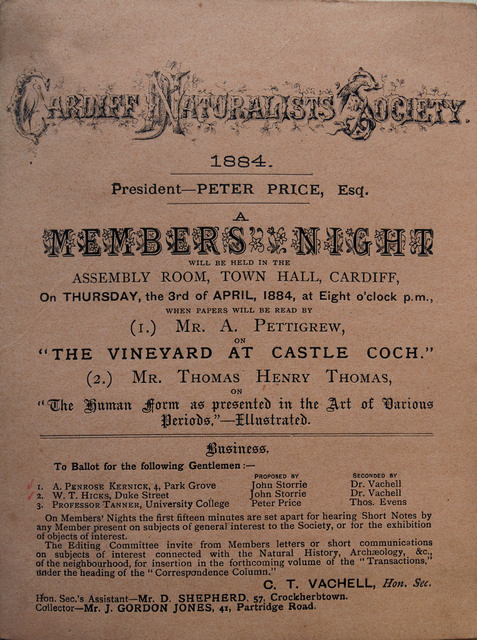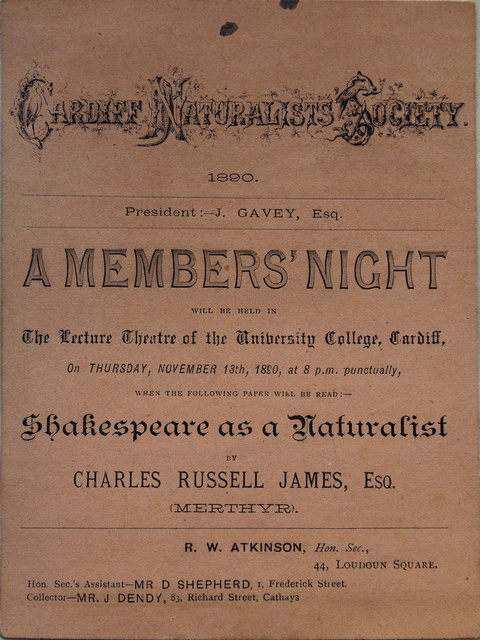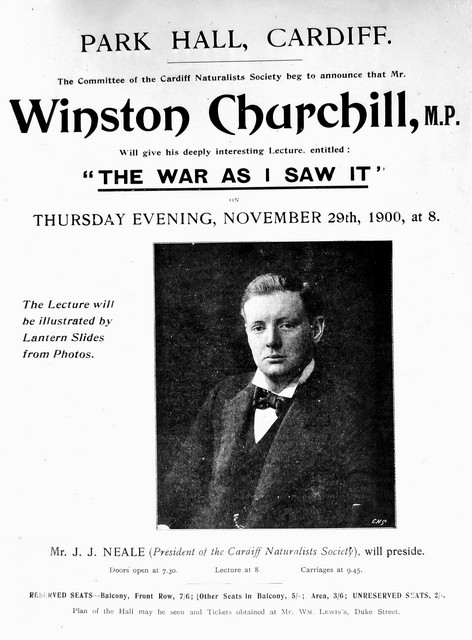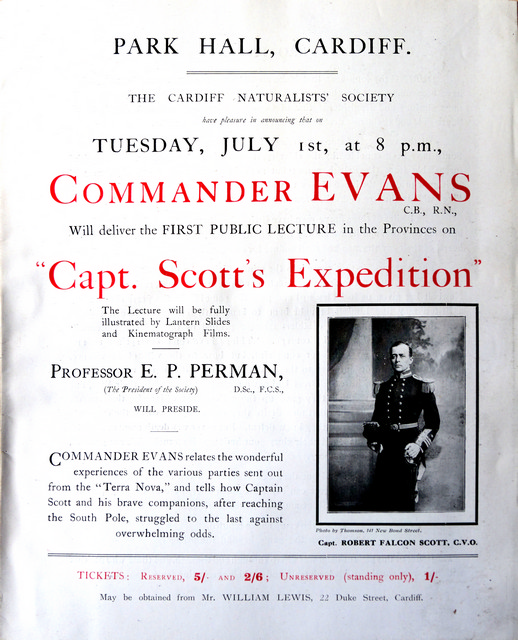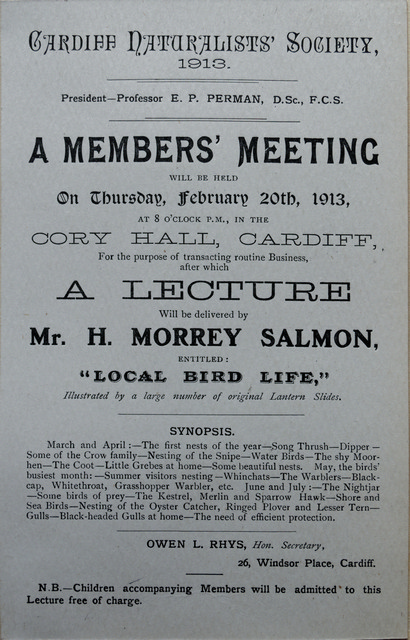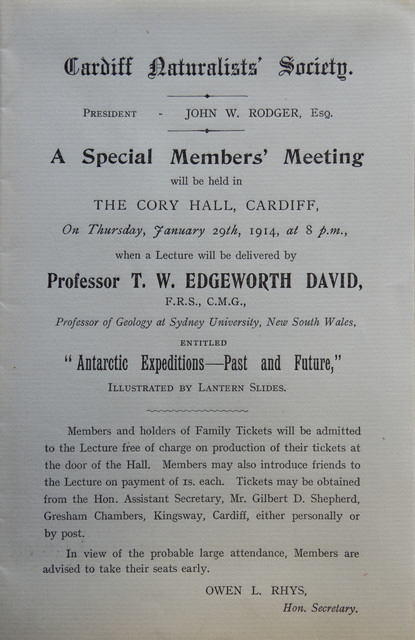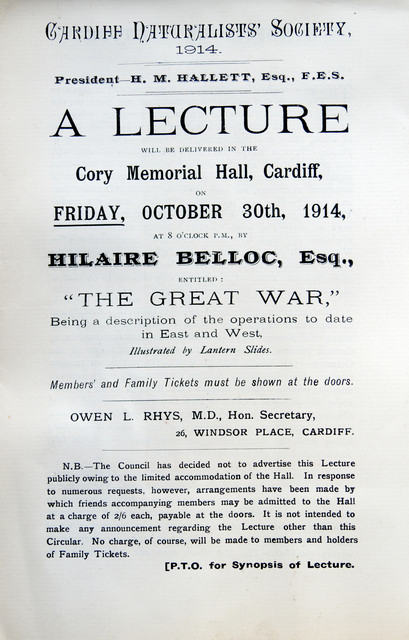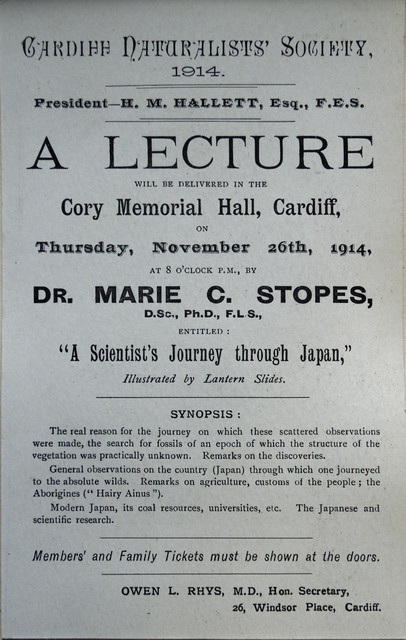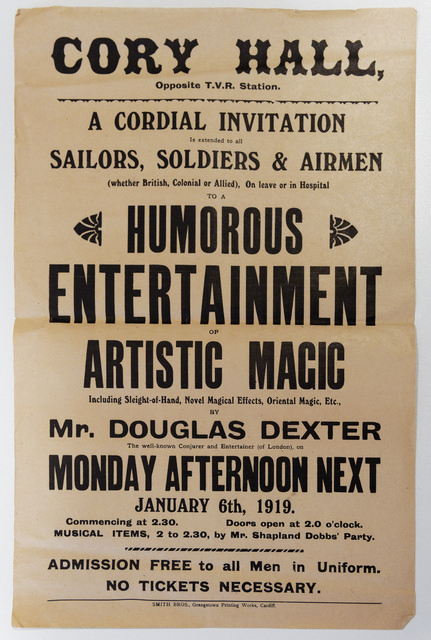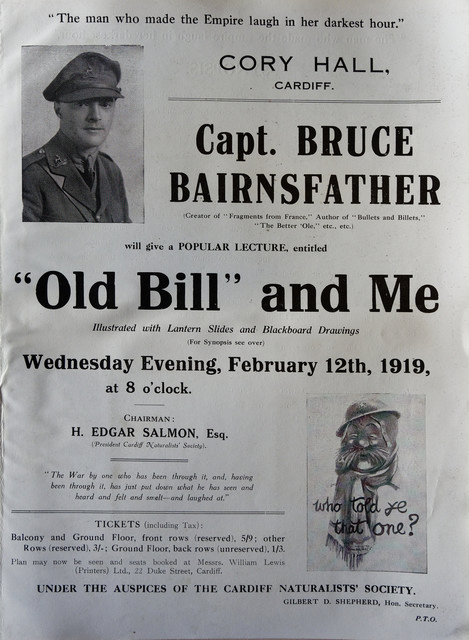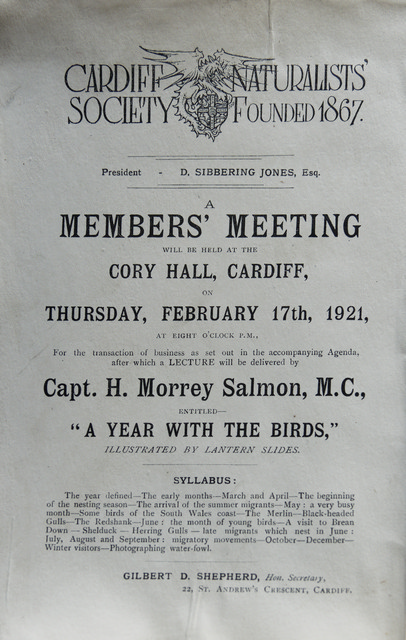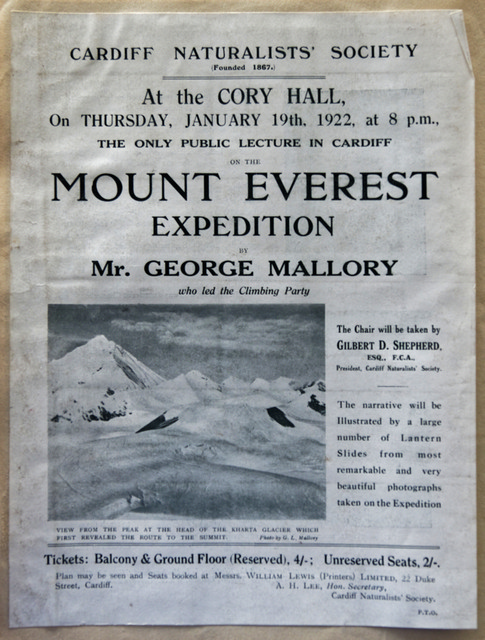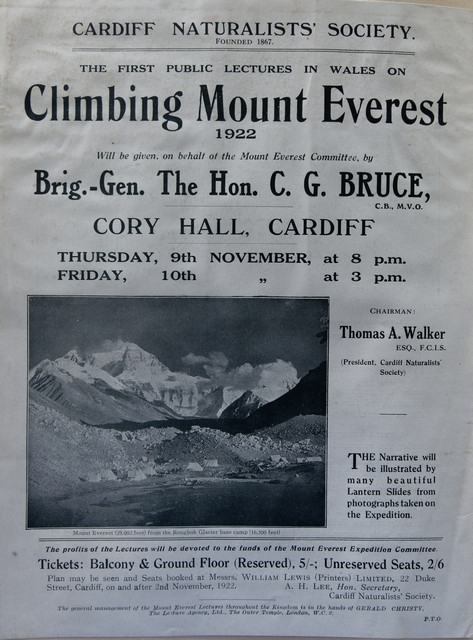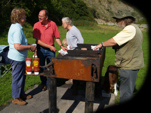
Cardiff
Naturalists' Society
Cymdeithas Naturiaethwyr
Caerdydd
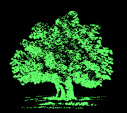
Outstanding and Famous Speakers of the last 150 years
|
Back to the 150th Anniversary index In the Last 150 year's the Cardiff Naturalists' Society has been host to many inspirational and informative speakers. We aim to continue this in our our current programme. This page gives some insight into the breadth of topics and some of the outstanding and famous speakers of the last 150 years. The images on this page are principally from our archives which are held at the Glamorgan Archive centre in Cardiff. They are displayed in broadly time order with a few exceptions where it seems appropriate to combine things. These are by no means all of the interesting lecturer's and (when I retire) at some time I would like to add more information to this archive and place more information into the public arena. if you are interested in further information on any of these posters or would like to licence a CNS image for use elsewhere please contact the society via the publicity officer email on the contacts page. Charles Dickens Junior 1891 One of the first most interesting names we noticed looking at the archive was Charles Dickens. This seemed surprising, but was possible as he lived until 1870. However on closer reading you can see this is the son of the great writer. Professor Boyd Dawkins speaking in 1882 As with any society it was important for the Cardiff Naturalists' Society to sponsor important and well known speakers in order to attract new members even from the earliest days. One we have found in our archive from 1882 was Professor Boyd Dawkins. Whilst famous for his work in Oxford, Somerset (Wookey Hole) and latterly Kent, it should not be forgotten that he was a "local" having been born at Buttington Vicarage in Montgomeryshire on 26 December 1837. He apparenrly attracted attention at age five by collecting fossils from the local colliery spoil heaps which is something that many Welsh geologists and naturalists have done. Shakespearian recital 1882 That same year we had some veritable culture with Shakespearian recitals. Fridtjof Nansen lecture from 1892 Fridtjof Nansen Fridtjof Nansen was a Norwegian explorer & scientist. He led the team that made the first crossing of the Greenland interior in 1888, and came to talk to the Society about that incredible journey in 1892. Fridtjof Nansen lecture from 1897 After that lecture he headed to the North pole but was forced to turn back on 7 April 1895, after observing that the way ahead was "a veritable chaos of iceblocks stretching as far as the horizon". He turned back at 86°13.6'N. Interestingly both Nansen and the Society must have had short memories because when he spoke again to the Society in 1897 it was billed as "Dr Nansen's first public appearance in Wales or the West of England" Members Evening 1884 Since the early years of the Society we have had a tradition that still continues with "Members Night" evenings where a number of members will provide a short talk rather than a brought in speaker for the whole evening event. The poster above shows one of these evenings with two very noteworthy speakers. First of all Andrew Pettigrew who was Head Gardener to the Third Marquis of Bute. We have a number of interesting coincidences in that he took up this position in 1867 which was the year the Society was formed, and that same year his son William Wallace (who was also a very active member of the Society) was born. The other speaker that night was Thomas Henry Thomas, Artist, Naturalist and 16th President Shakespeare as a Naturalist 1890 Having had recitals we had a possible explanation why Shakespeare was such an excellent subject for a Naturalists' Society Winston Churchill 1900 Winston Churchill (before he was Sir Winston) spoke to the Society on the topic of "The War as I Saw It". At first glance one could be forgiven for thinking this was one of the World Wars, but on inspection of the date it is clear that it was the Boer War. if you want to read about the service of Alfred William Sheen 39th President in that war just follow the link Commander Evans 1913 In 1913 we were once again hearing about unsuccessful polar expeditions. This time by Commander Edward Evans captain of the Terra Nova. He is not to be confused with Petty Officer Edgar Evans, who was a member of Scott's Polar party and died with Scott and his companions on the return journey from the Pole. H. Morrey Salmon 1913 That same year we had a lecture from "one of our own" who was relatively unknown at the time, but went on to become one of the most well known bird photographers and bird conservationists of his time. At this point he us simply Mr. H Morrey Salmon, but if you want to read about his achievements in wildlife and in wartime service you can read all about it on his presidents page T. W. Edgeworth David 1914 Even as the First World War was underway the Society were hosting lectures (the big difference between this war and the later war being the relative lack of aerial attacks which meant that evening events could largely continue in many areas. David was Welsh in origin having been born in St. Fagans near Cardiff he had strong connections with Cardiff and was obviously a big draw talking about his expedition to the south magnetic pole in 1908-09. Hilaire Belloc 1914 it may seem an odd subject for the author best known for his children's book of poems entitled Cautionary Tales for Children: Designed for the Admonition of Children between the ages of eight and fourteen years to be speaking on, but during the war Belloc was well known for writing and speaking about the progress of the war. As editor of Land and Water he made several trips to source information about the war Marie Stopes 1914 Marie Stopes is best known in general circles for her campaigns on Married Life and Birth Control, but to a naturalist she is also well known as a palaeobotanist. In 1907, she went to Japan on a scientific visit and spent eighteen months at the Imperial University, Tokyo. She had whilst out there, explored coal mines on Hokkaido for fossilised plants. it was on this basis that she spoke to the society in 1914. Douglas Dexter 1919 It may seem a strange event for a Natural History Society to be providing, but then again no more strange than some of the events we have had before, or since. There is a full write up about this event on the blog of the Glamorgan Archives ‘Humorous Entertainment of Artistic Magic’: Cardiff Naturalists’ Society Supporting the War Effort Many thanks to volunteer Tony Peters for providing that write-up. Captain Bruce Bairnsfather 1919 The event above was followed by another light hearted event which was a lecture by the ever popular Captain Bruce Bairnsfather. He was the most famous cartoonist of the First Wold War and especially well known for the "Old Bill" cartoons. Captain H. Morrey Salmon, M.C., 1921 Captain H. Morrey Salmon as he was in 1921 was a long standing member of the Society and went on to become Colonel H. Morrey Salmon, 72nd President, and we have a write-up about him on the presidents pages. George Mallory 1922 George Herbert Leigh Mallory to give his full name, was an English mountaineer who took part in the first three British expeditions to Mount Everest, in the early 1920s. In those days (as now) it was necessary for adventurers to raise funds by doing publicity tours and there were a number of lectures that year related to the expeditions (see next poster also). This lecture was given after the 1921 British Mount Everest reconnaissance expedition which had had the aim to "explore how it might be possible to get to the vicinity of Mount Everest, to reconnoitre possible routes for ascending the mountain, and – if possible – make the first ascent of the highest mountain in the world." Brigadier-General the Honourable Charles Granville Bruce 1922 Brigadier-General the Honourable Charles Granville Bruce was the leader of the second of the expeditions to Everest which had taken place between March and August 1922 and therefore was able to provide an updated talk in November of the same year. The two men would both take part in the 1924 expedition where Mallory would be lost on the mountain. His body being found some 75 years later in 1999 This work pauses here for now, as the author of this page needs to find more time to delve into the extensive archives. I hope that people reading this have found some of the posters informative and entertaining. I do not have a specific time for the resumption of this project - it is probably tied to my retirement in coming years. Back to the 150th Anniversary index See our Full list of Presidents These pages are part of the Cardiff Naturalists' Society 150th Anniversary celebrations and are about our history and are celebrating the people who developed our Society and helped build the city and the cultural heritage of Cardiff. You can read more about that using the links above If you want to read about the ways we study the wildlife and environment of the Cardiff area and its surroundings, and about the talks we have about the wildlife of the world, and find the programme of talks, walks and other events that we do then please take a look at our main website, our blog and our facebook and twitter feeds for up to date news |
